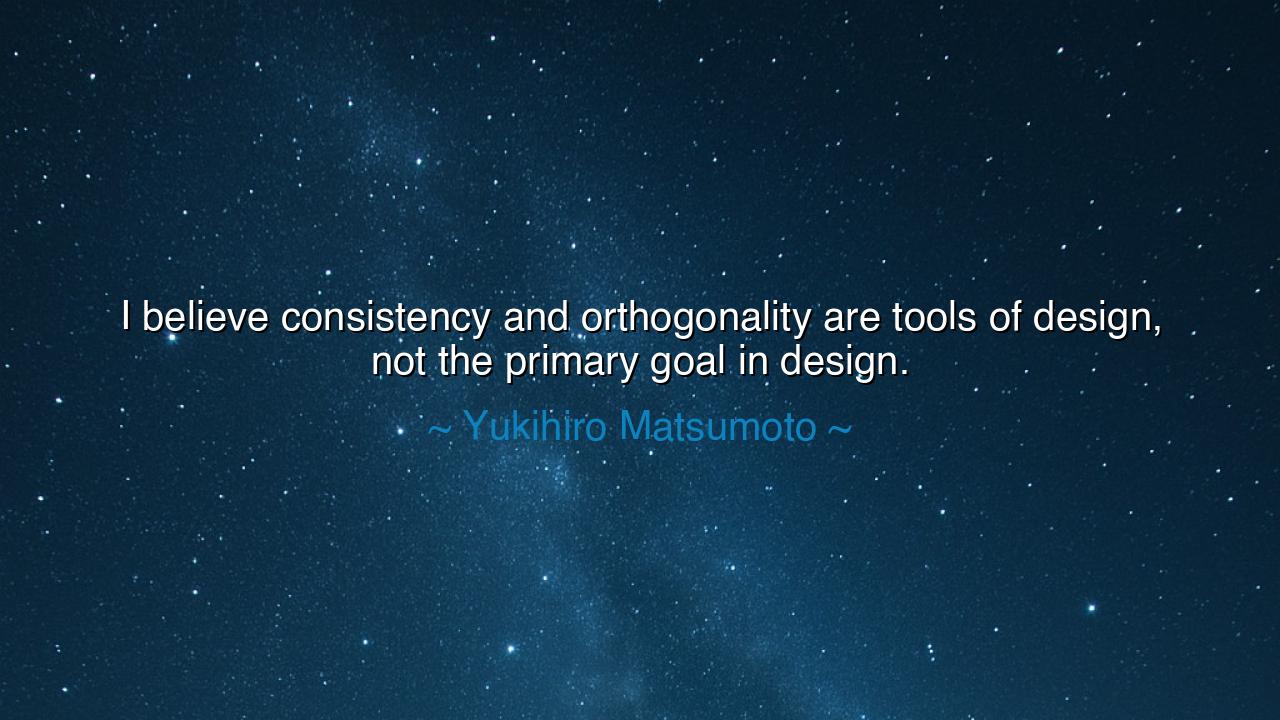
I believe consistency and orthogonality are tools of design, not
I believe consistency and orthogonality are tools of design, not the primary goal in design.






“I believe consistency and orthogonality are tools of design, not the primary goal in design.” Thus spoke Yukihiro Matsumoto, the creator of the Ruby programming language — a craftsman not of stone or steel, but of thought itself, weaving logic and beauty into the fabric of code. His words shine with quiet wisdom, reminding us that design, whether of software, architecture, or life itself, is not the worship of rules, but the pursuit of human harmony. In this single statement, Matsumoto strikes at the heart of creation — the truth that order and consistency, while noble, are not ends in themselves, but servants of something greater: joy, meaning, and usefulness.
When Matsumoto speaks of consistency and orthogonality, he names two principles revered by engineers and designers alike. Consistency is the quality of uniformity — the desire that every element behave predictably, that no surprise disturb the structure. Orthogonality is the principle that each component should stand independent, unentangled with others, so that complexity does not multiply. These are indeed powerful tools, and through them great systems have been built — bridges, languages, cities, civilizations. Yet Matsumoto warns us: to make these virtues the goal is to mistake the map for the journey. For design exists not to please the designer, nor to satisfy the rule, but to serve life itself.
The origin of this quote lies in Matsumoto’s philosophy behind Ruby — a language he forged not for machines, but for the happiness of the programmer. He believed that software, like art, should feel natural, expressive, and humane. The cold precision of consistency and orthogonality, though valuable, could not capture the fluid grace of human creativity. A design that obeys all the rules but delights no one is a lifeless perfection. Therefore, Matsumoto sought balance — a design guided by rules but liberated by empathy. His Ruby was not an instrument of rigidity, but a language of joy, where elegance served humanity, not the other way around.
This idea echoes through history. Consider the story of Leonardo da Vinci, whose genius defied the boundaries of discipline. In his paintings, he broke the strict geometries of perspective when the emotion of the scene demanded it. Though the Renaissance prized order, Leonardo understood that art lives only when rules serve the soul. His Last Supper is not perfect in symmetry, nor in the orthogonality of its lines, but it breathes — because the artist prioritized life over law. So too did Yukihiro Matsumoto remind his disciples in the art of code that structure, however logical, must yield to human intuition.
This truth is not confined to art or design, but applies to all creation. The engineer who builds without empathy may construct machines that function, but not inspire. The leader who governs by consistency alone may maintain order, but not justice. Even the teacher who clings too tightly to method forgets that the goal is not to complete the lesson, but to awaken the student’s mind. In every field, the rule must bow to the purpose, and the purpose is always life. For the rule is a compass — it points the way — but it is the heart that must decide where the journey ends.
Matsumoto’s wisdom also bears a hidden humility. He does not cast away discipline; he honors it as the foundation upon which true beauty stands. To use consistency and orthogonality as tools is to wield them with wisdom — to know when to apply and when to transcend them. The wise craftsman respects the grain of the wood but dares to carve beyond it; the wise composer follows rhythm but knows when silence speaks louder. Perfection without compassion creates sterility; but imperfection shaped by love creates art. In this balance lies the secret of all enduring design.
So let this be the lesson for all who create: use your tools, but do not become their servant. Let your structures serve your vision, and your vision serve the human heart. When you design, ask not only, “Is this consistent?” but also, “Does this bring life? Does it move the soul?” For the ultimate test of design is not in symmetry, but in connection — not in mechanical precision, but in human meaning.
Therefore, take the words of Yukihiro Matsumoto as both guidance and blessing: Let your work be ordered, but not enslaved by order; precise, but not imprisoned by precision. Remember that the goal of design is not the perfection of form, but the illumination of purpose. Build with clarity, yet leave room for wonder. For in that sacred balance between discipline and delight lies the true art of creation — where design ceases to be merely functional and becomes, at last, beautifully human.






AAdministratorAdministrator
Welcome, honored guests. Please leave a comment, we will respond soon